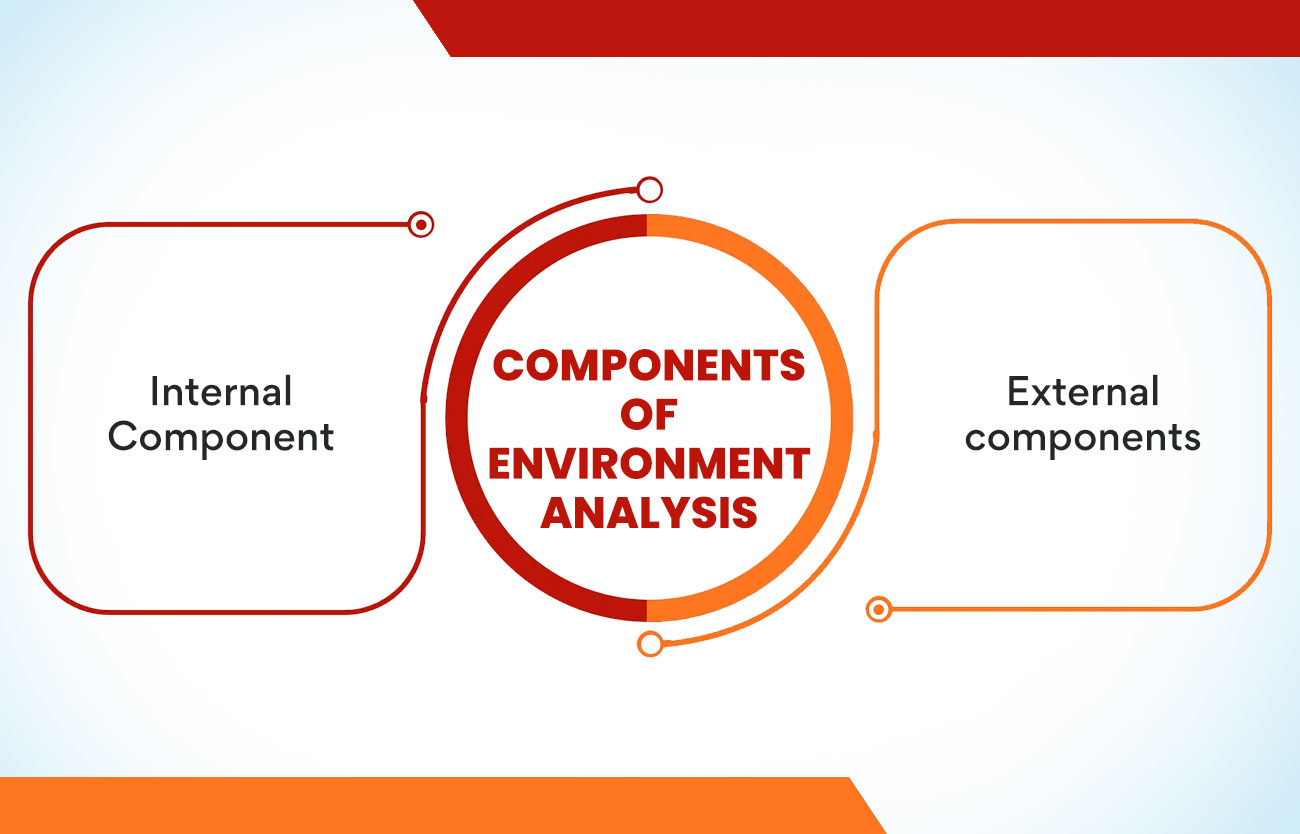What is Environment analysis in modern-day businesses?
Environmental analysis is a dynamic process that uses a 360-degree holistic approach to analyze the variables that affect the company environment rather than sticking to just one section. With a study on business environmental analysis, organizations can uncover internal and external factors that may negatively or positively affect their company. Businesses can foresee future opportunities and challenges by considering variables like the economy and technology. This might help them create a successful marketing plan by learning how their day-to-day activities are taking place using the study from the business environmental analysis.
Environmental study is one of the most extensive methods for strategically determining all internal and external aspects that impact a business’s future. This analysis is important because external components reflect possibilities and threats, while internal components show a company’s advantages and disadvantages. The environmental analysis also considers trends and major elements, for instance, changing fashion interest and how it could impact an apparel business. These evaluations can aid companies in becoming more appealing to customers.
Such measures considerably impact effectiveness, competitiveness, administration, judgment, and the company’s overall success. They also considerably contribute to the creation of successful business plans. Companies can develop plans that align with the shifting aspects of the company’s environment by studying the components. The internal wisdom furnished by environmental analysis is also used by businesses to improve their workforce capabilities, performance, client satisfaction, preservation cost, etc. Further, the external measures help in reacting to the context favorably and aligning the blueprints according to the ideas of the association.
An exercise in scenario planning is only concerned with examining the potential effects of unknowable factors or “ambiguity” just on an organization’s future and is better employed in conjunction with an environmental analysis. To benefit from environmental analysis, it is required for a company to transform the data into a form that can be used to set goals and create a plan for accomplishing them.
Components of environment analysis
Internal and external factors are the two main parts of an environmental analysis. Since we now know that an organization’s internal environment consists of things like its value system, goals, structure, culture, workforce, labor unions, technical capabilities, etc. On the other hand, various external elements have an impact on how a firm operates. These elements make up an organization’s external environment. Let us look at these components thoroughly below:
- Internal Component: These elements demand that businesses examine themselves. Based on the organization’s objective and vision, they assess its strong and weak elements. These elements also allow companies to reflect on their strategy and intentions for a predetermined time, like five or ten years. Many internal problems in a company are analyzed internally. The environmental analysis must address the following significant challenges based on the organization’s makeup;
- Financial standing
- Roles for products and services
- Product and service excellence
- External components: External factors, on the other hand, relate to important variables outside the organization. Businesses need to assess the challenges and opportunities in the following areas, Performance management:
- Market and industry trends
- Advantages and disadvantages of competition
- Your customers, including customer service
- Economic activities that may affect the organization
- Technology advancements in technology that can simplify processes
- Supply of workers and local labor markets
- Legal as well as political environment
The objective of conducting an environmental analysis
Despite knowledge about environmental analysis, entrepreneurs still wonder why it matters to their companies. Now that it is most likely clear why conducting an environmental analysis is crucial after reading the explanation above. If we conduct this study properly, we will understand how well businesses can draw in favorable environmental elements and reduce unfavorable ones. For the following reasons, environmental analysis is needed in all businesses:
- A company’s response to variations in important environmental factors is determined by environmental analysis.
- Businesses use this study to determine how potential changes impact their worth or market position.
- Through risk mitigation, environmental analysis may help businesses examine and monitor possible risks to your company.
- By identifying adjustments that can be made in a company to boost the competitiveness of its asset base, enhance client satisfaction, or increase performance, environmental analysis helps them find new opportunities.
- The environmental analysis informs management about the connections between an organizational framework and its operations.
- An organization can determine how the internal environment of the business is changing using environmental analysis.
- Because the environment changes so quickly, an institution’s harmony with its surroundings could be quickly upset. An environmental analysis can assist a company in identifying the root reasons for disharmony. The equilibrium point can then be achieved by making the needed modifications.
- Environmental analysis assists businesses in reducing the number of potential solutions and eliminating those manifestly incompatible with anticipated possibilities or risks. The analysis enables the removal of inappropriate options, allowing the focus to be placed on more effective alternative solutions.
An industry or business might develop efficient marketing plans and tactics to boost its competitive advantage. Doing several instances of studies based on inputs from managers, such as business plans and predictions, economic indicators on rivals and consumers, market analysis, and a range of other elements, is one technique to perform an environmental analysis. To learn more about such techniques from seasoned trainers, check out this comprehensive course on Business environmental analysis by XLRI.
Popular theories in environment analysis
For sound marketing decisions, the company’s future planning, product abandonment, new product launches, and strategic management depend on effective environmental analysis. Some of the main models used in the environmental analysis are:
- PESTLE Analysis: When we look broadly at macro issues that greatly affect the health of a particular industry or sector, this is effectively a bird’s eye perspective of business activity. This environment analysis helps entrepreneurs and strategy developers understand where their market is. It also aids in protecting the organization’s future state. Pestle analysis includes several variables that affect the workplace. It’s a macroeconomic technique utilized to grasp the external reality of a larger environmental investigation. Each letter in the acronym denotes a different element. Every industry or organization could be impacted by these elements, either directly or indirectly. PESTLE (also spelled as PESTEL) stands for the following terms:
- Political aspects – The political environment describes how the activities of the government impact corporate operations. Businesses must remain vigilant about political issues because they are typically out of control. Thus it becomes all the more important to prepare to accept its impact on their day-to-day activities. The political environment examines the following elements:
- Rules Regarding Entrance
- Tariffs and tax laws provide stability in the country.
- Rules And regulations
- Economic factors – The type and pace of economic activity in which a firm competes or conducts business are addressed. It’s crucial to take into account variables like GDP, the rate of unemployment, the exchange rate, and others. The following are a few economic factors you should research:
- Exchange rate for other currencies
- Fiscal as well as monetary policies
- Accessibility to Credit and Rate Of Unemployment
- Income Available to Prospective Clients
- Inflation Rate
- Percentage of inflation
- Social influences – Businesses must pay special attention to the rules, values, practices, culture, skills, language, tastes, and preferences of the people in this environment. The following are some of the important social and economic factors;
- Money Distributed
- Visitors’ level of education
- Domestic Organization
- Social Behavior of Individuals
- Demographic factors
- Cultural Effects of Gender
Read More: What is an Executive MBA For Working Professionals?
- Technical aspects – The success of an organization is discussed through technological advancements, technological level, technology acquisition, the research and development budget, etc. The following are a few technological elements:
- Modern technology platform
- Technological progress
- Technology obsolescence rate
- Recent Findings
- Legal aspects – The legislation, laws about business, courts, and the legal system combine up the legal environment in which a company operates. Yet, the following are some legal considerations:
- Laws for health and safety
- Intrusions on patents
- Competitive regulations
- Occupational Guidelines
- Rules for Products and Services
- Environmental factors – The crucial cultural traits of worldwide markets, pertinent global marketplaces, and massive global political rallies make up a company’s global environment. These are some of the primary environmental factors:
- The way people view and respond to the environment
- Rules About Power Consumption
- Disposing of Waste Laws
- Environment and Weather
- Location-specific Information
This approach presents one of the pillars of strategic management, which goes beyond simply analyzing the market to consider an organization’s objectives and the tactics used to achieve them. This model’s entire scope is essential for whatever sector a company may operate in. The significance of each aspect may vary depending on the type of industry, but conducting the PESTLE analysis is essential for any plan a firm wishes to design because it is a much more detailed version of the SWOT analysis.
- SWOT Analysis: Before formulating a business strategy, it is crucial to carry out the SWOT analysis as a component of internal emphasis. The method for handling risks must include everything. Understanding SWOT analysis is aided by identifying the strengths and weaknesses as an internal evaluation of a business or by focusing on controllable aspects. As a result, the business’s possibilities and dangers are evaluated from the outside, considering external forces and influences that aren’t under its control.
- Strengths
- What benefits does your company offer?
- What exclusive or inexpensive resources can you access that nobody else can?
- What do customers in your market think you’re good at?
- What characteristics suggest you “win business”?
- Weaknesses
- What might you change?
- What must you keep away from?
- What flaws are you most likely to be viewed as having by your economy?
- What elements contribute to your business decline?
- Opportunities
- What favorable possibilities can you see?
- What fascinating trends do you know about?
- Threats
- What challenges do you encounter?
- What are your rivals up to?
- Is your job at risk due to evolving technology?
- Do you have issues with bad debt or cash flow?
SWOT analysis can assist a company in exposing unsafe shortcomings and challenging hypotheses about its performance. It can provide fresh perspectives on where a company is right now and assist it in creating the ideal strategy for any circumstance if it uses it thoughtfully and in coordination.
Read More: Top IIM MBA for Working Professionals in 2024: Choose the Right MBA
Process of conducting environmental analysis in your business

It is quite clear now what environmental analysis is and how it can benefit a company. Let us now understand how should an environmental analysis be done. Though it is usually an ongoing process, there are pre-defined steps. The six steps of an effective environmental study are listed below:
- List the factors: Selecting the criteria requires careful evaluation, which is the first stage in conducting an effective business environment study. Constitutional, ethical, technological, financial, and other variables may also be involved. The environmental analysis’s important factors are determined by the sector in which the company operates. An IT company, for instance, is more concerned with technological matters, while a healthcare company would wish to examine its legal considerations.
- Analyze the elements critically: Analysts look at them while selecting the best ones for their business. Feedback on each of these criteria is gathered. They even conduct research and track the parameters. They have the option of vocally or in writing gathering information. Note-taking is one of the methods used to gather verbal data derived from on-ground research. In contrast, textual data is gathered through reading and scrutiny.
- Examine rivals: The next step is for businesses to examine the rivals and assess where they stand in the market. This aids them in identifying risks and investment opportunities. Companies use conventional or unconventional methods to gather data on rivals. Traditionally, knowledge is gathered from either primary or secondary sources. Snooping, ideally considered unconventional, can also be used to collect this information. They observe new developments among rivals and then incorporate them into their operations. Companies also gain insight into previous errors and try to work on them, which helps them improve organizational performance shortly.
- Consider organizational implications: After businesses have done their due diligence on their competitors’ actions, evaluating the implications of this information on their daily activities is necessary. To do this, strategy makers use the power of prediction and extrapolation. This helps them to estimate how specific factors will affect a firm via prediction. This aids in spotting dangers, chances, possibilities, weaknesses, and strengths. Analysts conduct surveys, brainstormed ideas, and more to forecast the effect. Decisions are made based on these collected data sets to enhance the company.
- Create a plan: Now that basic research is done, analysts at every organization develop a strategy after inspecting all external factors and assessing organizational impacts. They issue statements and remedies on enhancing efficiency as well as company operations. This strategy can help firms accomplish their main goals.
- Put the plan into practice: Finally, it’s time for the company to implement the strategy in its daily activities once the analysts create the plan. The strategy consists of tactics that the company must adopt to boost productivity. These approaches are differentiators, which means that each issue relating to a given aspect has a unique solution. Companies can take advantage of opportunities and prevent challenges after implementing the strategy.
Limitations of Business Environmental Analysis
Every model or study has its drawbacks. Similarly, environmental analysis is also subject to some restrictions. Listed below are these restrictions:
- Need for preparation for unexpected events – Future predictions based on conducted environmental analysis are not sure to occur as predicted. When employed in a business, this study fails to do away with uncertainty. On the other hand, environmental analysis should minimize the severity and frequency of surprises that could strike a commercial organization.
- No guarantee of organizational efficiency – Environmental analysis cannot guarantee good management performance. It simply functions as a method’s evaluation and creation input. The verifiability and accuracy of information are sometimes taken for granted by management, who rely on it blindly.
- Poorly Reliable – Typically, people rely too heavily on the data gathered from environmental analysis. Yet this should not be the case in the actual world. One is liable to need clarification when information is bombarded.
- A lack of a strategic plan – The key to every organizational progress is taking calculated risks and needing to be more adventurous. Environmental analysis frequently causes someone to be overly careful in their approach, and they are more prone to fall behind the events. So, this examination needs to be done strategically.
- Time-consuming and expensive – The gathering, processing, and analyzing information for predicting takes much time and money. Hence, prediction is only helpful because the benefits are worth the effort and expense required.
The Bottom Line
Ultimately, it is vital to appreciate that environmental analysis focuses on evaluating a firm’s surroundings and potential scenarios that may or may not impact its activities. The environmental analysis procedure is often drawn out since it takes much time. But for businesses to thrive and flourish in this ever-evolving marketing climate, entrepreneurs need to sharpen their skills in conducting this study. The outcome of the procedure after learning the skill will help learners enhances their organization’s performance. These companies can profit from effective tactics that improve operational efficiency. The income and profitability of a company will also increase significantly as a result of this study
More Information:
The Complete Guide To The IIM Raipur ePGP



























